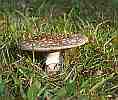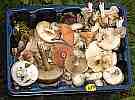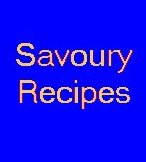
History
This page, and indeed, a large part of my leisure time are both thanks to cricket, or rather, cricket balls. One might wonder how this opening relates to recipes, and while I'm sure someone somewhere in the world will eat crickets, to my mind cricket balls offer somewhat less culinary scope. Think about it: crickets cooked and peeled would be nicely speared on cocktail sticks and presented hot, with a hotter chilli dip. That thought is almost attractive, but cricket balls present some difficulties - firstly in the cooking and secondly, in impaling them on cocktail sticks.
But I digress. Had I been a budding Brian Statham or an incipient Len Hutton this might never have been written, but I was neither. True, I was in the school first eleven, and at the time, the only eleven, but I had to be included because in a small prep school you had to consider the second oldest boy and the tallest (at eleven years old, for it was a very new shool) or you were scraping the bottom of the weenies' barrel for some lump of an eight year old.
I had creams. I had a good cricket bat bought of Messrs Selfridge, its quality endorsed on its face by the printed signature of Patsy Hendren. With it, I was probably of about average skill in ball-swatting. This might have had something to do with my later discovery in that famous gunsmith's, Thomas Bland, that I had a left master eye: but then, not knowing anything of master eyes, I batted right-handed. I wish I had known, because I've always been fairly ambiguous ambidextrous - while I write using my right hand I use a longbow left-handed, shoot from the left shoulder, and I play darts sinisterly. Anyway, to return to the job in hand, I was better with the ball: I could bowl the odd mean one which looked like a lob crying out to be lofted for six, but when it hit the track, its top-spin caused it miraculously to accelerate, and it converted into a swift daisy-cutter while the willow would waft wildly and airily long after the cherry had scuttled underneath the swing. To the surprise of some (not the least me, on occasion...) I might put a bottom spin on it so that it slowed and leapt upwards, sometimes offering a catch to close fielders¹. But around there, any resemblance between me and a cricketer ended.
¹ Not, you understand, Brian Close
What really let me down was my fielding prowess, which was so spectacularly negative that I was always placed where I could do least damage, for, if by some mischance, the ball should be edged my way, I could be relied upon to let it escape between my ankles, or if it were flighted by way of being a 'chance', I would drop it. I expect I must have caught the thing sometimes, but of that I have no recollection. Well, dammit, my bones had no padding and a cricket ball is hard, and all too often, fast. Indeed, this lack of padding made me heavier than water, and until I was about sixteen, I swam like a brick. That's my excuse anyway.
Anyway, when this tale unfolds I was eleven and it was a normal games period, and as usual, we had changed into our creams (and in some cases, whites...) in our dormitories, assembled and formed up, and then walked from the school in a crocodile2 into, and through the town, over the level-crossing and out on the ##### road to the municipal playing field. Shortly after arriving I was fielding in some position unknown to the text-book: somewhere, if I remember correctly, between deep fine leg and longstop, and I was bored.
2 We were in the crocodile, you understand, the school wasn't.3
3 Not a real crocodile: just a line of boys, two-by-two. No school can survive on a diet of boys eaten by crocodiles.4
4 Crocodiles probably can though, until the school runs out of boys.5
5 Or of course, girls.
This was where I made the biggest mistake of my life, and be it said, the best one: my roving eye fell upon some puffballs. Not giant ones6, but small, firm, round ones about the size of a marble jack7, and, there was a fielder well within range...
6 Langermannea gigantea
7 Bovista plumbea
The usual sequence followed: offence committed; authority alert to offence; "What are you doing?"; "Nothing, sir!"; "You were throwing something at Biddulph!"; "Only a puffball, sir..." "ONLY a puffball? See me after the game!"
There was an edge to his voice which suggeted that sacrilege had been committed.
When the fateful hour came, of course, I complied, with everyone else idly drifting the same way, quite accidentally, you understand... - I, because it was commanded, and they, perchance to enjoy seeing me reaping the well-deserved reward of my transgression8. But Mr. Churchman was not made of prepschoolmasterly stuff, just taking a year before going up to, if I remember correctly, Oxford.
8 Deserved, of course, for getting caught, not for committing the offence, which in itself was deemed quite admirable.
The punishment was a surprise to me and a disappointment to most of my fellows. "Go and find as many of those puffballs as you can, and bring them back to me, carefully."
I complied, wondering what devilry was afoot, but even my fertile imagination didn't stretch to considering that I might be made to share the fate of Socrates. Accordingly I presented around a dozen puffballs cradled in the pouch made by pulling out the bottom bit of my jumper at the front.
"Good. Take them back to school carefully. Don't squash them. Bring them up to my study after prep., and we'll cook them."
At the very least the words struck apprehension into my mind. Surely the offence of bunging Bovistæ wasn't a capital one9?
9 #The punishment fit the crime, tra-la, the punishment fit the crime... And anyway, I didn't know they were called Bovistae then.
"But sir! They're poisonous!" I remonstrated, for hadn't I been told so by the font of all knowledge, my mother? As a farmer's daughter and brought up in the countryside, she knew the names of everything, and as I found in later years, often, she was right.
"They're not poisonous:" he contradicted: "in fact, they're delicious. Anyone else who wants to come along is welcome too." So, carrying my doom carefully back the five or six furlongs to the school, and considering it unwise to jettison them on the way, arrived. When there, I put them somewhere safe and slotted back into the routine - until prep was over, that is. Then, I reported to Mr. Churchman's study because I had to. Chassis came along because he had an inquiring mind. Four others came too, to see me die.
On the surface just inside the door, and on the gas ring kindly provided by the school for boiling a kettle, a knob of butter made the acquaintance of a skillet, and while the butter was skating round the hot surface on a cushion of steam the puffballs were cleansed of any soil, and washed, and then rolled into the skillet and sizzled about in the hot ghee until they were golden brown. We sat at the table with a teaplate and a fork in front of each of us. Admittedly, the aroma of those puffballs was delicious, and when it came to the (presumed) fatal act of eating them, they tasted as good as they smelt. I sampled them because I had to and Chassis because he wanted to. The other four were chicken.
In the morning, much to my surprise I woke: not only was I still alive, I seemed to have no ill effects. I began taking a bit more interest in mushrooms from then on, but in those days (1951 - 1952) there were few books on the subject, and what there were cost several arms and just as many legs, and probably a few heads as well, but in 1954, by which time I had settled into the habit of collecting mainly the usual horse mushrooms, field mushrooms and puffballs, I had left the prep school10 and was a day-boy at a county grammar school11, I spotted a book in the library: Mushrooms and Toadstools by John Ramsbottom, in the Collins' New Naturalist series.
10 Frinton Preparatory School
11 Wanstead County High School
"Ho! I know something about them!" I remember thinking, so I took the book down from the shelf and began leafing through it. Gobsmacked, I realised in a flash that I knew next to nothing about the subject. I knew several types of mushroom one could eat, but they were either white on top and brown underneath, white and spherical or white and slightly club-shaped, and that was it. Here there were depicted ranks of mushrooms, and some of the most obviously poisonous ones were labelled 'edible'.
      
I took the book home and devoured it - not literally, of course, 'cos it takes a good fungus to do that. I renewed it and re-renewed it: indeed, I renewed it so often that the leaf on the inside cover they stamp with its return date was completely filled before I stopped withdrawing it. By that time I had learnt that Dr. John Ramsbottom was Curator of Mycology at the British Museum of Natural History, and that if I sent specimens there, they would be identified12.
12 Later, when the service was moved to Kew, the same care was not bestowed: whereas the MBNH (Dept of Mycology) used to open parcels containing specimens immediately on receipt, Kew tends to allow them to decompose into a glop of evil maggot-heaving gunge - and then have the audacity to complain!
This (British Museum) datum was a handy thing to know, as the book wasn't exactly a field guide, and field guides were practically non-existent then anyway. I was able to contribute several interesting specimens to their collection over the years, but generally, they confirmed the edibility of the sample I sent. Those who have grown up with the internet really can't imagine the obstacles in the way of studying an out-of-the-ordinary subject before that time. The curtors kindly showed me, and allowed me to handle, a book (I have a vague recollection that it was in two volumes) crammed with colour plates. I abandoned any hope of saving up for it as soon as they told me its pre-war price. I can't remember exactly how much it was, but I think it was something like three hundred and fifty pounds
By some quirk of good fortune I received a prize on Speech Day for the greatest number of GCE 'O'-level passed in my stream, and I chose Mushrooms and Toadstools for that august award. I have to admit that for the amount of actual swotting I put in I really didn't deserve the prize: I suppose I was just fortunate that I could soak up knowledge like a sponge and it failed to drain away, and a lot of it remains to this day, be it said.
The hall was packed with around seven hundred and forty pupils, the staff and some parents. At a table in the middle of the stage were seated the Head and one or two others - probably the girls' head and the senior master, but I don't remember who - maybe the Chairman of the Governors? By the wings, stage right and at the front stood Prof. Alan Bullock, the source of the 'Speech'.
A succession of the anointed mounted the stage, crossed it and shook hands with the professor, received a book and retraced his or her steps to the applause of the assembly. I remember crossing the stage and as I approached him, the prof. picked up the book, looked at it, looked at me, then back again to the book. He showed it to me. "Is this yours?" he asked, obviously a bit puzzled12a.
12a I looked an awful lot younger then...14
14 Indeed, I looked somewhat younger than a lot of my fellows.
"Yessir!"
I accepted the book in my left hand, and a vice-like grip crushed my right, and my arm was reciprocated as the handle of the town pump in the square might have been during a major conflagration. "It's good to see someone choosing an academic book as a prize instead of the usual Black Beauties and Ivanhoes!" he said, relinquishing my right arm before it fell off.
The Headmaster was beaming. "Chalk one up to me!" I thought: "Must be the first time he's basked in reflected glory from me!"
That book went hiking and camping with me. It went to woods in Essex, Sussex and Kent. It went with me for a whole summer holiday to Scotland (which is a story in itself), and had to be replaced years later because it was falling to pieces. By that time, field guides were beginning to appear, and my library of mycological tomes has, like Topsy, growed. The latest find was added during the September of 2012.15
15 Update: I've added several books since then. The last one, 'A Field Guide in Colour to Mushrooms and Other Fungi' by Dr. M. Svrcek and Dr. J. Kubicka is riddled with misinformation, and some very unrepresentative photographs. Published in English in 1979 by Octopus.
If you want to get a really excellent book, you can do a lot worse than 'Mushrooms and Other Fungi of Great Britain and Europe' by Roger Phillips, which I was advised to get by the Department of Mycology at the British Museum of Natural History a long time ago. First published by Pan, and republished by Macmillan

Off to get new goodies?
or back to main page.
|













